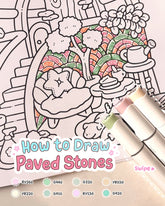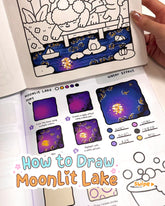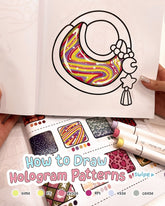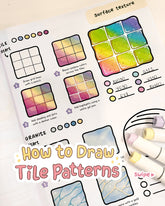How to Use Alcohol Markers for Beginners?
Table of Contents
If alcohol markers have ever scared you off, this is your sign to finally try them.
We’ll break down how to use alcohol markers in the most beginner-friendly way possible, so you can skip the stress and enjoy the color magic.
What Are Alcohol Markers?
Alcohol markers use an alcohol-based ink instead of water, allowing colors to dry quickly and blend smoothly. The ink is translucent, making it ideal for layering and achieving even tones without streaks.
Their smooth blending, quick-dry nature and vibrant color output make them a favorite choice for artists, designers, and hobbyists who value precision and control in their work.
How Do Alcohol Markers Work?
How alcohol markers perform depends on your pressure, the type of nib, and the paper you use.
Pressure Matters
The pressure you use affects how much ink the paper absorbs. A heavier hand gives deeper tones, while a lighter touch keeps the color soft and even.
Type of Nibs

Most alcohol markers come with one of these two nib types:
- Brush tip: Great for smooth blends, gradients, and natural shading.
- Broad tip: Ideal for covering large areas and switching between thick and thin lines.
Each nib offers a different level of control, letting you shift easily from bold coverage to fine precision.
How to Layer with Alcohol Markers?

If your colors keep looking flat, you don’t need fancy tricks. A little layering will fix that.
Layering helps alcohol markers show their full potential. Because the ink is translucent, each layer slightly darkens the one beneath it, creating smooth, even color. Here’s how to practice layering:
-
Start light: Begin with the lightest color, then slowly add darker tones on top.
-
Let it rest: Wait a few seconds between layers to avoid bleeding.
-
Build gradually: Add depth in small steps rather than one heavy coat.
-
Mix colors: Layer different shades to create new tones or warmth.
- Add accents: Use darker strokes last to shape shadows or define edges.
The last color you add usually stands out the most. And if a spot feels too dark, you can lightly go over it with a lighter marker to soften it.
How to Blend with Alcohol Markers?

Blending is one of the most rewarding parts of using alcohol markers. It’s about learning how the ink behaves and how timing affects the way colors merge on paper. Tips to blend alcohol markers effectively:
-
Light to Dark: Start with the lighter shade, then add the darker one beside it. Go over the edge again with the light color to soften the blend.
-
Two-Color Overlap: Layer two colors where they meet and move each marker gently back and forth while the ink is still wet.
-
Colorless Blender: Use the clear blender to merge colors or lighten small sections by pushing the ink outward.
-
Blend into White: Fade your color gradually into the white of the paper to create a clean, natural highlight.
- Flicking Technique: Use quick, tapered strokes from dark to light for smooth texture, like hair or fabric folds.
Blending takes practice, but it quickly becomes second nature. The more you experiment, the more natural and effortless your colors will feel.
How to Shade with Alcohol Markers?

Ever wonder how some pages just pop off the paper? Shading adds depth and makes your artwork feel three-dimensional. With alcohol markers, it’s all about light, layering and control.
-
Start light, then add shadow
Begin with your lightest color and gradually build darker tones where light doesn’t reach. It’s easier to deepen a color later than to correct one that’s already too dark.
-
Use grays to guide your shading
Map your shadows with warm or cool gray tones before adding color. The gray base helps define light direction and keeps the overall tone balanced.
-
Play with tone families
Using a few shades from the same color group is the easiest way to get smooth shading. Start light, drop in a darker shade for shadows, then use a mid-tone to blend everything together. It keeps your transitions soft and natural.
-
Adjust with your blender
If your shadows look too harsh, use a colorless blender to soften them. You can even lift a bit of ink to bring back highlights or create a gentle fade. Think of it as your little “undo” tool.
Common Mistakes Beginners Make (and How to Avoid Them)

-
Marker bleed through
Mistake: Alcohol markers can bleed through thin pages and ruin the artwork underneath.
Fix: Always place a protector (plastic) sheet behind the page you're working on.
-
Dry marker
Mistake: Forgot to cap your marker? That juicy tip can dry up fast!
Fix: Always recap right after use. If it’s already dry, try rehydrating with a refill or let it go with grace and grab a fresh one.
-
Over-blending
Blending for too long or pressing too hard can leave streaks or tear the paper. Use a light touch and stop once colors begin to mix evenly.
-
Skipping color tests
Always test your color blends on scrap paper first. It helps you see how the shades will mix before touching your final page.
-
Leaving caps off
Alcohol ink dries out fast. Always recap your markers right after using them to keep the tips juicy and ready.
-
Color bleeding outside the lines
If your colors keep bleeding, slow down and work in smaller areas. Give each layer a second to dry before adding more ink.
-
Uneven tones
Going straight in with dark shades makes blending harder. Try layering from light to dark instead for smoother transitions.
Each trial helps you understand how alcohol markers behave and how to manage flow, layering and color transitions with more confidence.
FAQs
1. How should I start using Alcohol markers for the first time?
Begin on smooth marker paper and practice small swatches first. Learn how the ink moves before blending large areas. It’s part of learning how to use alcohol markers properly and finding the pace that works best for you.
2. Why do my Alcohol markers look streaky?
Usually it’s the paper or the drying speed. Try working a bit faster and use smooth marker paper, your blending will get softer with time.
3. Do Alcohol markers bleed?
Alcohol markers often bleed through pages, so use thick, smooth paper and place a sheet underneath. Light pressure and steady strokes help control the ink flow.
4. What’s the best way to shade with Alcohol markers?
Use the side of your brush tip and layer softly toward where shadows fall. Mix gray or a darker version of your main color to create natural depth.
5. How do I keep Alcohol markers smooth over time?
Keep your markers capped tightly and store them flat in a cool, shaded place away from sunlight. Wipe off any extra ink from the nib to keep the flow smooth and the colors consistent.
6. What’s the difference between Alcohol markers and Water-based ones?
Alcohol markers use dye in alcohol, so they blend smoothly and dry quickly. Water-based markers are gentler and easier to control for kids or journaling. Neither is better, it’s about what you need: alcohol for rich blending, water-based for light coloring or note-taking.
7. Can refilling Alcohol markers affect their performance?
Refilling helps them last longer, but overfilling can flood the nib or make colors uneven. Add ink slowly and let it soak in, a quick wipe after refilling keeps tips clean and consistent.
8. How long do Alcohol markers last?
Most alcohol markers last several months to a few years, depending on how often you use them and how well they’re stored.
9. What are the benefits of Alcohol markers?
Alcohol markers blend easily and dry quickly, making colors look smooth and even. They’re simple to use for beginners and work well for both everyday coloring and creative projects.











